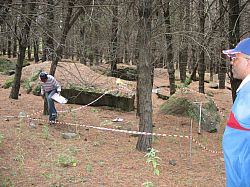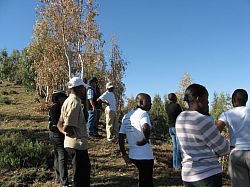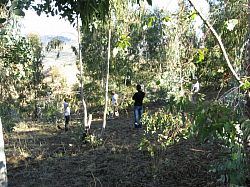Purpose
 Dr. Letsela Supervises Transect Techniques
Dr. Letsela Supervises Transect Techniques
This survey will describe the structure of the plant community at each research site by sampling the species composition and relative abundance of each species in the plant community. The botanical survey will help us understand the impact, if any, of the trees on the vegetation of the area. The trees provide a different microhabitat from grasses and forbs that are typical of the Lesotho environment. We believe that introducing them in this environment is likely to have had an impact on species as well as the soils. This is why we are taking stock of what grows underneath the trees as well as taking soil samples. We believe this will tell us something about the transformation process that is occurring at the microhabitat level. Soil samples taken at the centre of each plot will not only provide an idea of the level of plant nutrients in the plot, but also indicate the distribution of soil types within the site and suggest soil profile changes.
 Social Science assistants' orientation to transects
Social Science assistants' orientation to transects
Technique
A botanical survey using the Braun-Blanquet method is being implemented at each site. Transects 200 m long and 50 m apart are being made down slope. On each transect, 5x5 m plots are being sampled every 20 metres. A standard form guides data collection. At each plot a GPS reference is recorded (longitude, latitude and altitude), all the non-tree plants in the plot are listed, a soil sample is taken from the centre of the plot using a soil augur, and the plot is verbally described. Each time a new plant is encountered, a sample is collected in a plant press for identification by a taxonomist at the herbarium. Soil samples are air dried and stored, to be shipped to a South African lab for analysis.
Implementation
 Biologists teach Social Scientists how to mark transect plots
Biologists teach Social Scientists how to mark transect plots
In the field, Dr. Letsela, the biologist, took the lead, instructing co-Senior Researchers and field assistants in technique. All of the Senior Researchers and four Field Assistants participated in data collection at the first site (Thaba Phatšoa). The Field Assistants consisted of 4 recent university graduates selected by Dr. Letsela - two males and two females, three with training in biology/botany and one economist.
A hard frost ended the botanical research on April 28th, 2007 - botanical surveys had been completed at two sites, Thaba Phatšoa and ha Rakoro. Data collection will resume once the rains have come and vegetation is re-established; this is expected to be the latter half of November 2007.


